
© Erik Tomasson. (Click image for larger version)
San Francisco Ballet
Unbound Festival Program A: The Collective Agreement, Bound To and Hurry Up, We’re Dreaming
★★★★✰
San Francisco, War Memorial Opera House
20 April 2018
www.sfballet.org
If Helgi Tomasson was hoping that Unbound: A Festival of New Works would generate heated debate on the state of ballet today, his wish has already been fulfilled just one night into the massive festival at San Francisco Ballet, where he is artistic director. Unbound opened Friday, 20, with world premieres by Alonzo King, Christopher Wheeldon and Justin Peck. At the intervals, even the closest of ballet friends argued opposing perspectives on each ballet. Statements pro and con continued into the wee hours via text message.
Tomasson commissioned 12 choreographers in all for Unbound, and their works will continue to be unveiled and repeated over 17 days. It is a mind-boggling quantity of new work, and with themes like the gender binary (Myles Thatcher’s Otherness) and Pablo Picasso’s epic painting Guernica (Annabelle Lopez Ochoa’s cubist ballet of the same name), the polarization is sure to continue.
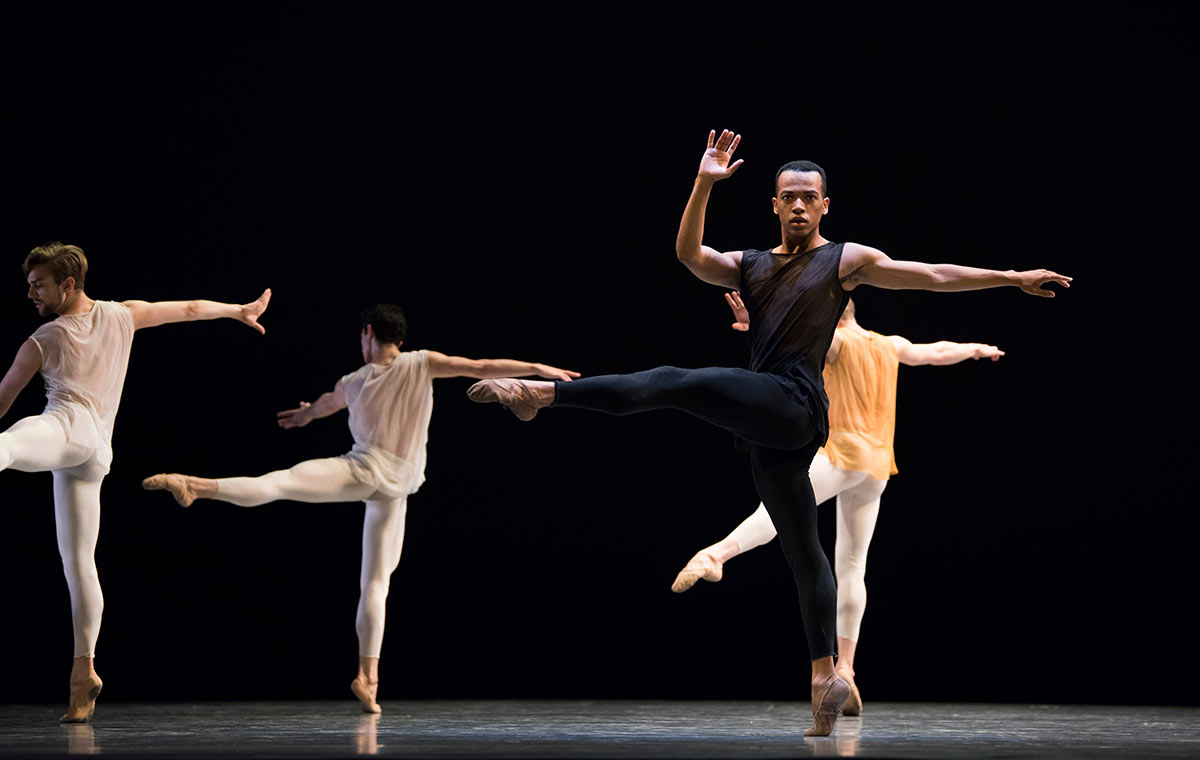
© Erik Tomasson. (Click image for larger version)
In his first commission for SFB, King brought his extreme-ballet style and spiritual ethos to The Collective Agreement, starring Sofiane Sylve and Tiit Helimets, and Jahna Frantziskonis and Joseph Warton as lead couples surrounded a chaotic 10-dancer ensemble. SFB dancers can do pretty much any movement in the contemporary realm, and they brought speed, attack and a game willingness to Agreement.
The alien movement vocabulary never quite synced with Jason Moran’s orchestral original score, played by the Ballet’s orchestra and conducted by Martin West. King’s mannered choreography seems best embodied by his own dancers, who are practiced in his ultra-fast counterbalanced turns, contralateral extensions, extreme flexibility and minute, singular details that are more decorative than functional, yet play a defining role in his choreography.

© Erik Tomasson. (Click image for larger version)
Lines dancers also share King’s vision of personal growth and universal communion; that was missing here, and so the communal purpose that holds King’s works together. The Collective Agreement never really gels as a whole. Only corps dancers Solomon Golding and Myles Thatcher tapped the main artery of King’s unique physicality, Golding in devilishly complex turns with arms raised outward in an overhead V, and Thatcher with a dynamic center of gravity and gorgeously supple and open épaulement.
Wheeldon was in his wheelhouse with Bound To, his tenth creation for SFB. The work brought to bear his theatrical instincts and his knack for discerning what each dancer does best and choreographing to it. Inspired by the emotional alienation caused by our obsessive intimacy with cell phones, Bound To opens with a dozen dancers gazing into handheld devices that reflected back a bright-white glow. The devices serve as lighting elements and limit movement to what dancers can do with both eyes and one hand otherwise occupied.
It sounds too on-the-nose to work, but it’s very effective. An empty-handed Dores André tries to lure Benjamin Freemantle to put his phone away and dance with her (hard to imagine anyone resisting that invitation). His eyes follow its light while he absentmindedly partners her; when he finally puts the phone in his pocket and fully connects with her, it’s a felt reminder of the beauty you yourself might be missing by mainlining social media.

© Erik Tomasson. (Click image for larger version)
An Isadora Duncan–esque quartet for André, Sasha De Sola, Isabella De Vivo and Jennifer Stahl beautifully realized Keaton Henson’s neo-folk rock music, played live by the orchestra (under David Briskin) and on recording. Angelo Greco’s impassioned solo tapped into raw desperation and isolation, while Lonnie Weeks’ closing solo put a well-deserved spotlight on the talented corps dancer, who will be promoted to soloist as of next season.
Video projections and backlit shadows augmented asymmetrical scenery by Jean-Marc Puissant, who also designed the understated costumes. But the final projection, a title card describing the rise in teen suicides related to social media, overstated the point.

© Erik Tomasson. (Click image for larger version)
SFB is having a Justin Peck moment, between the 2016 commission In the Countenance of Kings, this season’s performance of his acclaimed Rodeo: Four Dance Episodes and his festival commission, Hurry Up, We’re Dreaming. Peck’s latest sneaker ballet is set to selections from M83’s electronic album of the same name; it’s stirring and sometimes mesmerizing music, but across 30 minutes I found it gratingly same-y (a point of discussion with friends who adore the music).
True to its name, Hurry Up has an antic, madcap drive, and it would benefit from more rein than it got. Peck’s recent Broadway experience, choreographing the revival of Rodgers and Hammerstein’s Carousel, may have rubbed off a bit too much; the opening and closing ensembles made me wince with their ear-to-ear smiles and the aerobic giddiness of an Up with People assembly. Reid & Harriet’s Lurex leggings, shorts and loose tops became a muddy blur against the dungeon-like darkness of the sans-backdrop stage.
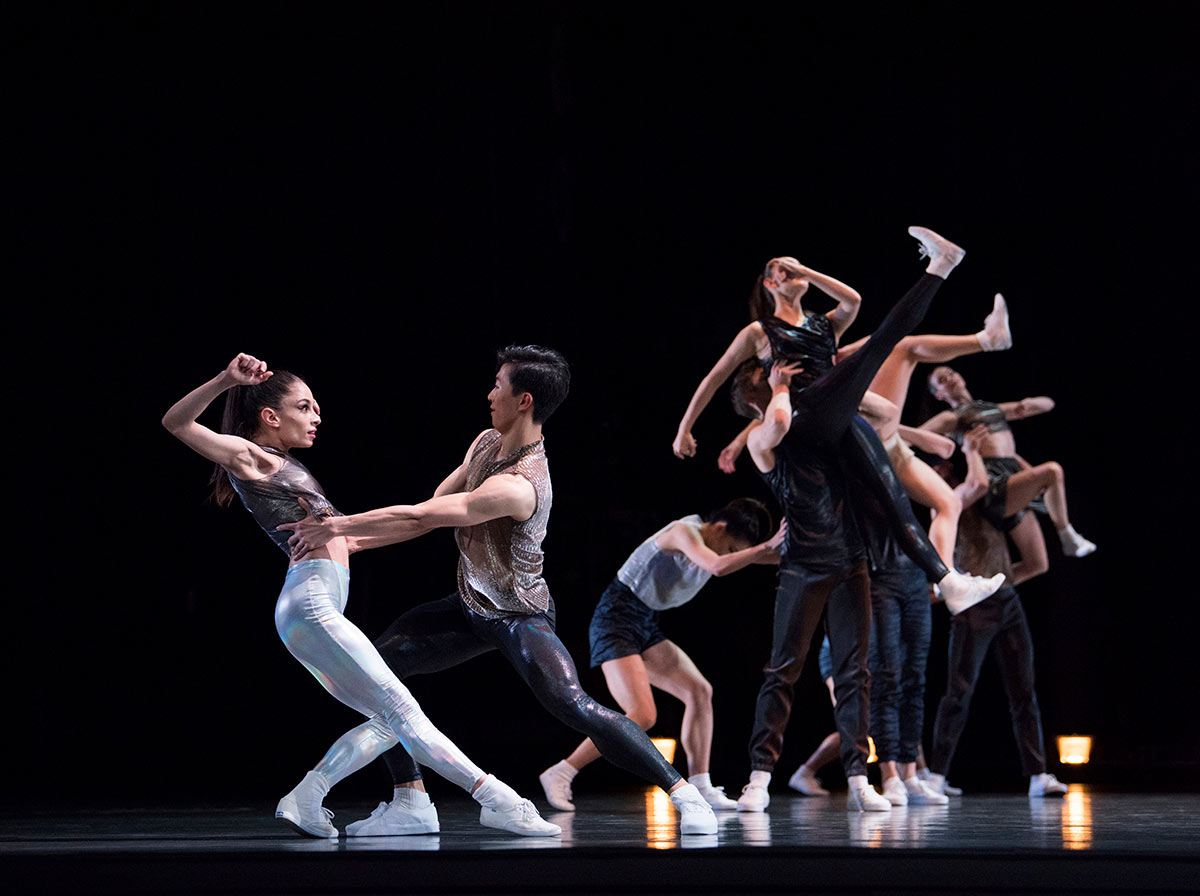
© Erik Tomasson. (Click image for larger version)
Where Hurry Up works is in the duets, which were flawlessly executed by André with Wei Wang (lots of high kicks) and Ulrik Birkkjaer and Gabriela Gonzales (floor rolls). Peck could have built the entire ballet around his duet for Sarah Van Patten and Luke Ingham, set to the poignant song “Wait.” He constructed their adagio with repeated phrases of low lifts, turns and direction changes, looped together and linked by quotidian walking. Unhurried and present in each passing moment, Van Patten and Ingham expanded and contracted with shared breath, although they rarely made eye contact. “Wait” runs nearly six minutes, but forever wouldn’t have been too long to take in their exquisite dancing.












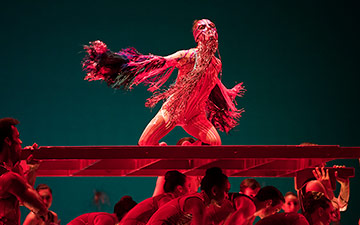

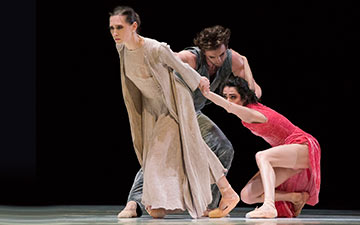
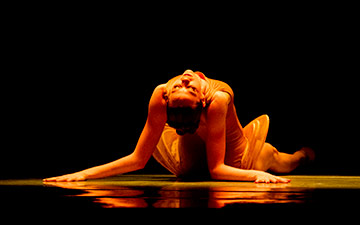
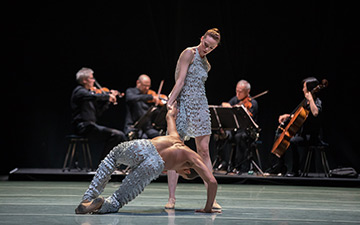
You must be logged in to post a comment.